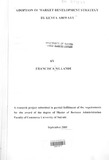| dc.description.abstract | The study was undertaken to investigate and document the experiences of a firm at the
peak of market development. This stems from the fact that there have been a number of
studies done in the past and have yielded mixed results. The study took Kenya Airways
as a unit of study.
The research problem was therefore to answer the questions; What is the extent of market
development within Kenya Airways? What factors determine market development?
What is the implementation process of market development? To be able to derive this
information, a case study design was used. This is because of the very probing nature of
a case study that would help achieve the objectives of the study.
The study results gave indications to the extent of Kenya Airways market development,
the reasons for market development, the implementation of the said strategy and
performance of the firm in light of this strategy. The extent of market development was
looked at from the perspective of market development by breadth and mode. Market
development mode established that the company largely opened up new routes in 7
countries. In Africa; Republic of South Africa, Djibouti, Mali and Senegal; in Europe,
Turkey and in the Far East, Thailand and China.
It was established that choice of market development is mainly due to the strategic intent
of the company. In implementation, the major structures included the board, the chief
executive, the commercial director and the network planning and strategy division. The
process that the strategy was planned and the chronology of market development since
2003 is given. The performance indicators of the firm have been presented. These
indicators include financial, internal as well as customer perspective. The indicators
present an all rounded perspective on market development and why Kenya Airways may
be considered successful with market development.
The limitations of the study included; the company policy on information outflow, the
significant use of secondary data, other factors contributing to performance other than
market development and the policy of consolidating the accounts. For further research it
was recommended that there should be a study on a firm that has had disastrous results
with market development; a study on a number of firms in the same industry and find out
their experiences with market development; a study on competitive advantage derived
from market development and a study on the impact of market development on the
different business units in an expanded firm. | en |

